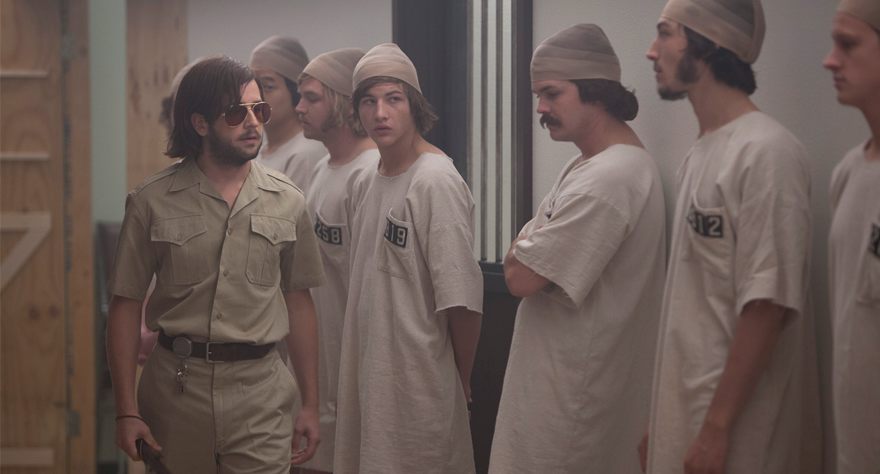
The legendary aspects of this true-life social experiment make up for its procedural approach.

The legendary aspects of this true-life social experiment make up for its procedural approach.
In 1971, Stanford professor Philip Zimbardo began what was supposed to be a two-week experiment on the effects of a prison environment on both prisoners and guards. A group of male students, still hanging around during the summer break, volunteered to take part in the study for its guarantee of $15 dollars a day. Classrooms turned into prison cells, a hallway became the cafeteria, a broom closet acted as “The Hole,” and the volunteers split into two groups: prisoners and guards. Zimbardo had no idea how dangerous and unethical the experiment would turn out to be. Both sides almost immediately absorbed into the roles they were given, with the guards physically and psychologically abusing their prisoners. Zimbardo pulled the plug on the study six days in after the abuse—and his allowing of it—reached a breaking point. Zimbardo’s project, like Stanley Milgram’s studies on obeying authority figures (coincidentally receiving its own cinematic treatment this year as well), is now known one of the most infamous experiments on social psychology. The ethics of the experiment are dubious, but the outcome continues to remain a chilling reminder of how fragile our identities can be underneath the power of societal structures.
That kind of material begs for a film adaptation, and after nearly 45 years of false starts, Zimbardo’s experiment has finally made it to the big screen in The Stanford Prison Experiment. The plain, descriptive title reflects director Kyle Patrick Alvarez and screenwriter Tim Talbott’s approach to the material (adapted from Zimbardo’s 2007 book The Lucifer Effect); this is little more than a straight up re-enactment of the experiment itself. Billy Crudup plays Zimbardo, and aside from a moment with his girlfriend and former student Christina Maslach (Olivia Thirlby), the film’s focus is more procedural than personal. This choice makes perfect sense, and it’s not the first time someone has stubbornly stuck to the facts to make their point clear. Craig Zobel did the same thing with Compliance, a film that meticulously recreated an incident so preposterous it was difficult to believe it really happened. Zobel’s direction was stomach-churning by design, and it worked brilliantly. Alvarez does the same thing here, and while the results are certainly effective, they’re not as powerful.
That could be due to the fact that Alvarez has a bigger scale to work with, considering The Stanford Prison Experiment has an ensemble of around two dozen actors. Talbott’s screenplay winds up honing in on a few of the test subjects, including Ezra Miller & Tye Sheridan as the more rebellious prisoners in the group, and Michael Angarano playing a prison guard who fully embraces his ability to torment and abuse the inmates. The ensemble works together quite well, with most of them taking full opportunity of the brief moments they get to shine. Crudup turns out to be one of the weaker links since the attempts to sympathize with him fall flat as he allows the experiment to devolve more and more. Miller, Sheridan, and Angarano are all standouts, but the most impressive turn comes from Nelsan Ellis as Jesse Fletcher, a former prisoner hired on by Zimbardo to ensure the experiment’s authenticity. A sequence where Fletcher improvises a brutal takedown of one prisoner (Johnny Simmons) during a mock parole hearing is riveting to watch, as Fletcher begins relishing in his chance to play the part of those who oppressed him for so long.
In fact, the most compelling moments of The Stanford Prison Experiment occur between the observers and not the participants, with Zimbardo and his colleagues slowly realizing they’ve become a part of the study. But the ongoing turmoil in the mock prison is what primarily drives the film, and it’s fascinating to watch how quickly things spiral out of control. Alvarez doesn’t sustain the tension from the situation as each day passes, and much like the experiment itself it feels like the film starts to slip out of his hands once the two-hour runtime starts getting felt. By the time the climax hits—where Zimbardo finally reaches his breaking point—its impact doesn’t match the psychological degradation shown earlier.
But at least the lacking conclusion—including an awkward and misguided coda that has the cast re-enacting documentary footage—doesn’t take away from the power of what came before it. Alvarez does a terrific job at cranking up the tension over the first two acts, and at some points it’s easy to get immersed in the roleplaying going on, believing in the simulation because of the very real emotions going on within it. Jas Shelton’s excellent cinematography goes a long way in keeping the claustrophobic, oppressive mood going, mainly by shooting the tight, cramped and dull office settings with a wide Cinemascope ratio, a choice that makes every character look as trapped as they feel. The Stanford Prison Experiment’s procedural approach to Zimbardo’s now legendary study may only work up to a certain point, but even so it’s hard to deny how gripping this fact-based drama can get.